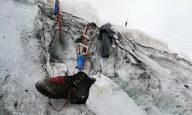 On Friday, a tragic incident occurred on the Matterhorn, one of the most iconic and challenging peaks in the Alps, resulting in the death of a mountaineer. The Matterhorn, standing at 4,478 meters, is not only famous for its distinctive pyramid shape but also for the technical challenges it presents to climbers.
On Friday, a tragic incident occurred on the Matterhorn, one of the most iconic and challenging peaks in the Alps, resulting in the death of a mountaineer. The Matterhorn, standing at 4,478 meters, is not only famous for its distinctive pyramid shape but also for the technical challenges it presents to climbers.
This incident highlights the inherent dangers of high-altitude climbing and raises questions about safety measures in mountaineering.
The climber, whose identity has not yet been released, was part of a group attempting to summit the Matterhorn. Climbing the Matterhorn is a formidable endeavor that attracts thousands of mountaineers each year, from seasoned professionals to ambitious novices. The mountain is notorious for its unpredictable weather conditions and steep, icy slopes, making it a serious test of skill and endurance.
Eyewitness accounts suggest that the climber fell while descending from the summit, a common phase of climbing accidents. Descents can often be more perilous than ascents, as fatigue sets in and climbers may let their guard down. The descent from the Matterhorn involves navigating challenging sections that require careful foot placement and strategic use of climbing gear.
The presence of loose rock and the potential for sudden weather changes can turn a safe descent into a life-threatening situation.
Search and rescue operations were quickly initiated following the report of the incident. The Swiss Alpine Rescue Service is well-equipped for emergencies in high-altitude environments, employing helicopters and skilled mountaineers trained for such rescues. Unfortunately, despite their rapid response, the climber was pronounced dead at the scene, underscoring the grim reality of mountain accidents.
This incident serves as a reminder of the risks associated with mountaineering. While many climbers prepare extensively—undergoing training, acquiring technical skills, and assessing their physical fitness—there are variables beyond their control. Weather conditions, rock stability, and personal health can drastically affect a climb’s outcome. In the case of the Matterhorn, its notorious reputation is well-earned; the mountain has claimed numerous lives over the years, often due to falls or severe weather changes.
The death of this climber has sparked discussions within the climbing community about safety protocols. Many experienced mountaineers emphasize the importance of assessing one’s own limits and the conditions of the mountain before embarking on such climbs. The use of ropes, harnesses, and other safety equipment is critical, but they cannot eliminate all risks. Some climbers argue that more stringent regulations regarding experience levels for those attempting to summit iconic peaks like the Matterhorn should be considered.
Additionally, this incident has prompted inquiries into the role of guides in high-altitude climbing. Many climbers opt to hire professional mountain guides to enhance their safety and improve their chances of a successful summit. Guides provide not only technical expertise but also crucial insights into navigating the mountain’s challenges. However, even with guides, accidents can occur, emphasizing that safety is ultimately a shared responsibility between climbers and their guides.
The Matterhorn, while a breathtaking destination, demands respect and caution. Climbers are encouraged to engage in thorough preparation, including studying the mountain’s routes, weather patterns, and the physical demands of the climb. Training on similar terrains and understanding emergency procedures can be vital. The loss of life on such climbs is a somber reminder of the sport’s risks and the profound beauty that often comes with them.
The emotional impact of such tragedies extends beyond the immediate climbing community. Families and friends of the deceased are left to grapple with their loss, often compounded by the nature of the sport. Mountaineering can evoke a mix of admiration and concern from loved ones, who may struggle to understand the allure of such dangerous pursuits. The psychological toll of such incidents can lead to increased scrutiny of climbing practices, both personally and within the broader community.
In the aftermath of this tragedy, the climbing community is likely to engage in conversations about risk management, preparation, and support systems for climbers. Many seasoned climbers advocate for a culture of safety where sharing experiences and lessons learned can help prevent future accidents. Mentorship programs and increased accessibility to safety training could be beneficial in fostering a safer environment for climbers of all skill levels.
Moreover, this incident could encourage discussions around environmental stewardship on popular climbing routes. The Matterhorn attracts not only climbers but also tourists who come to admire its majesty. As such, maintaining the integrity of the mountain while ensuring the safety of those who attempt to climb it is a critical balance to strike. Education on environmental responsibility can promote a sustainable approach to mountaineering, ensuring that future generations can experience the thrill of the climb without compromising the mountain’s natural beauty.
In conclusion, the death of a mountaineer on the Matterhorn serves as a poignant reminder of the inherent risks associated with high-altitude climbing. As the community reflects on this tragedy, there is an opportunity to strengthen safety protocols, enhance training programs, and promote a culture of caution and respect for the mountains. The allure of the Matterhorn continues to draw climbers from around the world, but as this incident demonstrates, the pursuit of adventure must be tempered with an awareness of the unpredictable nature of the mountains. It is a call to honor those who have lost their lives in pursuit of their passions by prioritizing safety and responsible climbing practices.
Leave a Reply